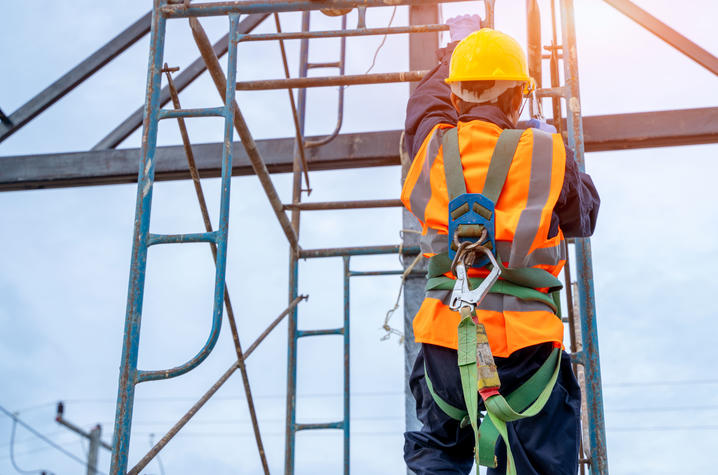KOSHS highlights ladder safety for National Safety Stand-Down Week

LEXINGTON, Ky. (May 6, 2024) — Falls from elevation rank nationally as the second leading cause of unintentional injury-related deaths among workers. In 2022, falls accounted for 700 construction worker fatalities, according to the U.S. Bureau of Labor Statistics. To address this, the 11th annual National Safety Stand-Down to Prevent Falls in Construction will be held from May 6-10, 2024. Established by the Occupational Safety and Health Administration (OSHA), this initiative aims to raise awareness and promote fall prevention practices in the construction industry.
During the 2024 National Safety Stand-Down, OSHA, along with the National Safety Council and numerous other organizations, urges employers to allocate a few minutes during the week for discussions on fall protection and safety measures when working at heights.
A safety stand-down is a practice in the construction industry where construction activities are temporarily halted to provide an opportunity for employers and employees to engage in discussions about identifying hazards, implementing preventive measures and reinforcing safety protocols.
To promote this year's Stand-Down to Prevent Falls in Construction, the Kentucky Occupational Safety and Health Surveillance (KOSHS) program at the Kentucky Injury Prevention and Research Center has released a Hazard Alert to bring awareness about the increasing risks associated with ladder-related accidents.
"We've seen a concerning trend of ladder-related falls in Kentucky, with 447 construction worker injuries leading to lost work time between 2013 and 2022 and, unfortunately, eight fatalities during the same period," said Rebecca Honaker, research director for KOSHS.
Hazard Alerts are short, informative bulletins for stand-down trainings designed to raise awareness about specific dangers in the workplace. They typically are two pages long and are intended to help employers and workers understand and avoid workplace risks. They include real-world examples of workplace incidents, relevant statistics, safety recommendations for employers, and additional resources for further information on the specific hazard being addressed.
The Hazard Alert issued in advance of this year's National Safety Stand-Down highlights two fatalities that occurred in Kentucky. One involves a 52-year-old carpenter who was taking measurements for a plywood installation at a restaurant. Witnesses reported that while there were several scissor lifts available, the carpenter chose to use a 6-foot fiberglass step ladder while his co-worker used a 10-foot fiberglass step ladder. While holding one end of a measuring tape and reaching beyond the side rails, the carpenter's ladder tipped over, causing him to fall onto the concrete floor. He died from the injuries sustained in the fall three days later.
A company representative told KOSHS investigators that the company did not have a formal safety program in place.
“Working from heights is inherently risky, and it's critical that employers and workers prioritize safety at all times,” said Honaker. “A small slip on a ladder can result in severe injuries or fatalities. Constant vigilance and proper safety measures are the only way to prevent these tragic outcomes."
The Hazard Alert provides eight recommendations derived from best practices established by the Occupational Safety and Health Administration and the National Institute for Occupational Safety and Health, with additional input from industry experts.
The recommendations are:
- Train each worker to recognize and minimize ladder-related hazards.
- For work at heights, consider using a scaffold or aerial lift. The wider work platform and guardrails reduce the risk of falling.
- Inspect ladders for defects or damage each time they are used. If a ladder is damaged, tag it “do not use.”
- Make sure the ladder is positioned on level, solid footing.
- Always check a ladder’s duty rating to make sure it will support the weight of you and your tools.
- Position the ladder as close as possible to the work being done to avoid overreaching. Keep your body centered between the side rails of the ladder. Even a slight overreach can lead to a fall.
- Secure the area around ladders that are placed in locations where they can be bumped, such as in passageways or doorways.
- Never step on the top rung of a ladder.
KOSHS has produced toolkits on Preventing Falls in Construction as well as Preventing Falls through Skylights that contain educational materials employers may want to utilize for their stand-down events.
KOSHS, an occupational surveillance program of the Kentucky Injury Prevention and Research Center and the Kentucky Department for Public Health, monitors workplace fatalities and develops toolkits, fatality reports, and Hazard Alerts to provide targeted recommendations for workplace injury prevention.
Learn more about the National Safety Stand-down to Prevent Falls in Construction here.
This work was supported by the National Institute of Occupational Safety and Health (NIOSH), Centers for Disease Control and Prevention (CDC) of the U.S. Department of Health and Human Services (HHS) as part of cooperative agreement 5 U60OH008483 totaling $1,601,266 with 0% financed with nongovernmental sources. The contents are those of the author(s) and do not necessarily represent the official views of, nor an endorsement by, NIOSH, CDC, HHS, or the U.S. government.
As the state’s flagship, land-grant institution, the University of Kentucky exists to advance the Commonwealth. We do that by preparing the next generation of leaders — placing students at the heart of everything we do — and transforming the lives of Kentuckians through education, research and creative work, service and health care. We pride ourselves on being a catalyst for breakthroughs and a force for healing, a place where ingenuity unfolds. It's all made possible by our people — visionaries, disruptors and pioneers — who make up 200 academic programs, a $476.5 million research and development enterprise and a world-class medical center, all on one campus.




